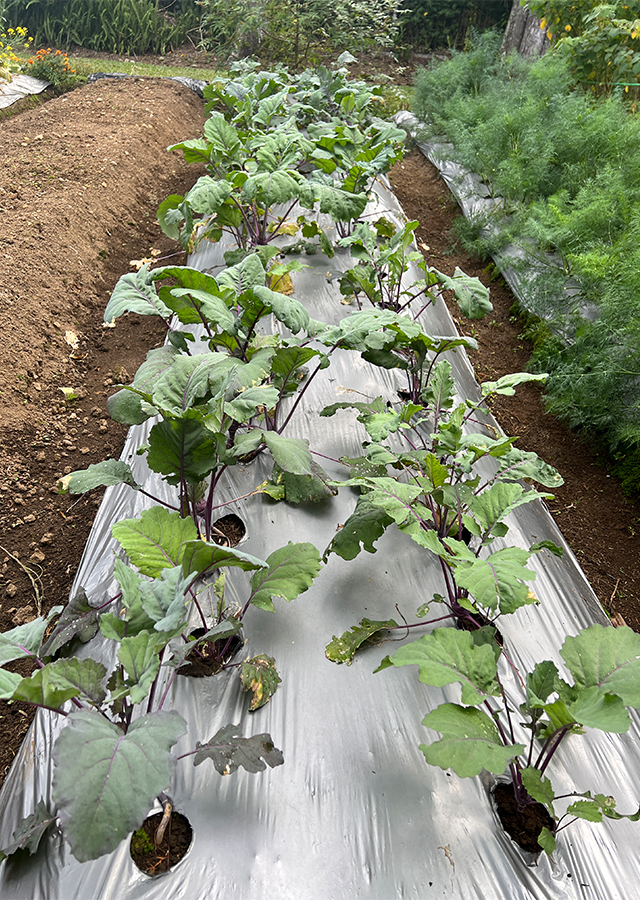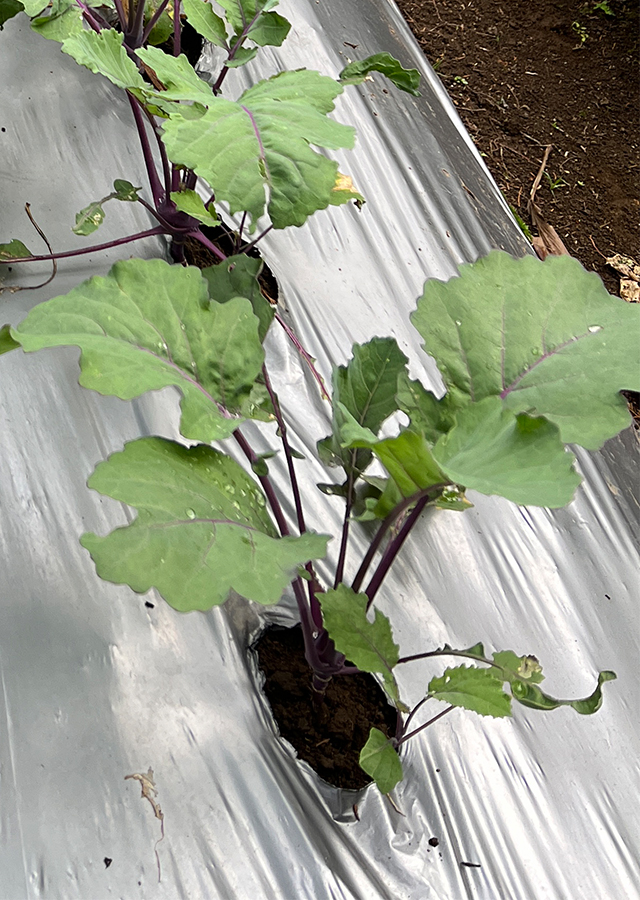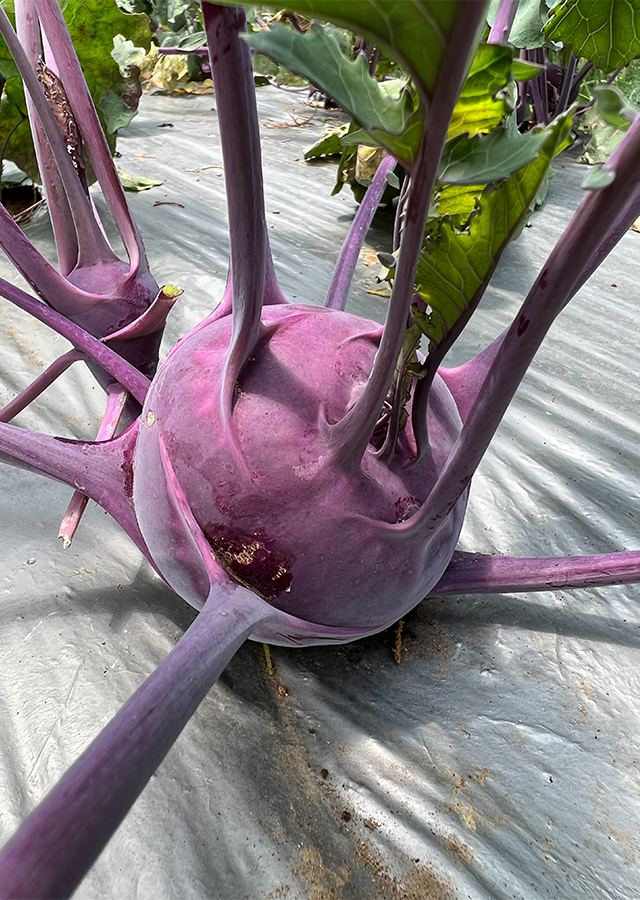Kohlrabi
Brassica oleracea var. gongylodes L.
Brassicaceae
Location in our garden
Vegetable



Synonym
-
Habitus
Herbaceous. An erect biennial herb, growing up to 0.5 m tall.
Part Used
Leaves
Tuber
Growing Requirements
Full Sunshine
Habitat
Mountains
Overview
Brassica oleracea var. gongylodes L. is native to north-western Europe, where it was developed from marrow-stem kale. The first record dates from the 16th century. Besides in Europe, North America and temperate parts of Asia, kohlrabi is also grown in subtropical Asia, e.g. in India, China and northern Vietnam. It is grown for the flattened globose to ovoid swollen stem (stem tuber), which is cut in pieces and cooked, but also used in soups or eaten raw in salads, and used for fodder (as livestock feed). Kohlrabi belongs to the Brassica family which includes other cool season vegetables such as kale, Brussels sprouts, broccoli, cauliflower and cabbage.
Vernacular Names
Chou-rave (French), Cavolo rapa (Italian), Colinabo (Spanish), Da tou cai (Chinese), Kolrabi (Tagalog-Philippines).
Agroecology
Kohlrabi is easily grown in organically rich, consistently moist, well-drained loams in full sun. Soil pH should be between 6 and 7. It is typically grown in the cool temperatures of spring or fall. It needs cool temperatures to produce the best crop. Plants generally grow poorly when daytime temperatures consistently exceed 26.5 °C.
Morphology
- Root - a taproot and lateral roots, and root system strongly branched.
- Batang - tidak bercabang, bengkak, seperti umbi berdiameter hingga 12 cm, hijau pucat hingga keunguan.
- Leaves - alternate, simple or with some small side lobes at base; stipules absent; all leaves with distinct, slender petiole; blade ovate in outline, irregularly incised, blue-green.
- Flower - inflorescence a terminal paniculate raceme, bisexual, regular, 4-merous; pedicel up to 2 cm long, ascending; sepals oblong, c. 1 cm long, erect; petals obovate, 1.5–2 cm long, clawed, pale to bright yellow or whitish; stamens 6; ovary superior, cylindrical, 2-celled, stigma globose.
- Fruit - a linear silique 5–10 cm × 5 mm, with a tapering beak 5–15 mm long, dehiscent, up to 30-seeded.
- Seeds - globose, 1.5–2 mm in diameter, finely reticulate, brown.
Cultivation
- Generatively propagated by seeds. Seeds are sown on seedbeds or modules.
- Young seedlings may have to be shaded to prevent sun scorching. Seed requirements are 300–700 g/ha.
- Transplanting to the field should be done when seedlings have 7–9 true leaves, 30–40 days after sowing.
- Set plants in the ground about 10-15 cm apart in rows that are 45 cm apart.
Chemical Constituents
Alkaloids, flavonoids, resins, saponins, tannins, volatile oils (4-methylthiobutyl isothiocyanate, 3-butenyl isothiocyanate. allylisothiocyanate, 5-methylthiiopentanitrile, 3-mediylthiopropylisothiocyanate and 2-phenylethyl isothiocyanate), chlorogenic acid, catechol, epi epigallocatechin, epicatechin3-O-gallate, fatty acids (linoleic, palmitic and oleic acids), glucosinolates, anthocyanins, carotenoids, and phenylpropanoids.
Traditional Medicinal Uses
Studies have suggested antidiabetic, anti-inflammatory, antioxidant, anticancer, antibacterial properties.
Part Used
Reference Sources
- Kew Royal Botanic Gardens. (No date). Plant of the World Online: Brassica oleracea var. gongylodes L.. https://powo.science.kew.org/taxon/urn:lsid:ipni.org:names:60452376-2. 18-11-2022.
- Missouri Botanical Garden. (No date). Brassica oleracea (Gongylodes Group). https://www.missouribotanicalgarden.org/PlantFinder/PlantFinderDetails.aspx?taxonid=257407&isprofile=0&. 18-11-2022.
- Stuartxchange. (2021). Philippine Medicinal Plants: Kolrabi. http://www.stuartxchange.org/Kolrabi. 18-11-2022.
- Tjeertes, P. (2019). Brassica oleracea L. (kohlrabi). PROTABase. https://web.archive.org/web/20081205073932/http://database.prota.org/dbtw-wpd/exec/dbtwpub.dll?AC=QBE_QUERY&BU=http%3A%2F%2Fdatabase.prota.org%2Fsearch.htm&TN=PROTAB~1&QB0=AND&QF0=Species+Code&QI0=Brassica+oleracea+kohlrabi&RF=Webdisplay. 18-11-2022.

